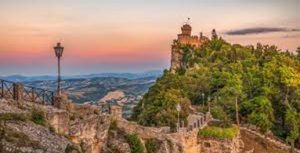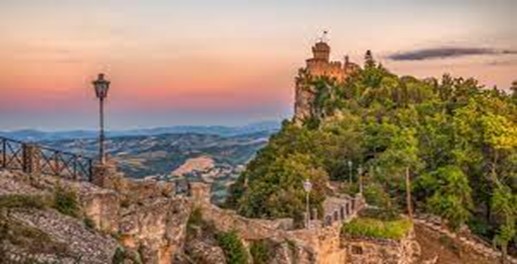Discovering San Marino
Discovering San Marino
Nestled on Mount Titano’s slopes along the Adriatic coast in central Italy, San Marino is Europe’s second smallest independent state, following Vatican City and Monaco. It once held the title of the world’s tiniest republic before Nauru gained independence in 1968.

Exploring San Marino’s Landscape
San Marino boasts an intriguing geography within its irregular rectangular shape, spanning approximately 8 miles from northeast to southwest. The land is traversed by Marano and Ausa streams, flowing gracefully into the Adriatic Sea, alongside the San Marino stream merging with the Marecchia River. Central to the landscape is the commanding limestone behemoth, Mount Titano, soaring to 2,424 feet, its presence unmistakable. Rolling hills radiate southwestward, while the northeastern terrain gently descends towards the Romagna plain and the Adriatic coast. This picturesque panorama includes Mount Titano’s iconic triple fortifications atop its three summits, a sight visible from miles away. In 2008, this remarkable blend of nature and history earned the UNESCO World Heritage designation.
San Marino enjoys a mild and temperate climate, offering summer highs around 70°F (approximately 26°C) and winter highs hovering in the teens °F (about −7°C). Annual rainfall typically falls between 22 inches (560 mm) and 32 inches (800 mm), nurturing the Mediterranean-inspired flora. The landscape showcases olive, pine, oak, ash, poplar, cedar, elm, along with an array of grasses and flowers. Indigenous and domestic fauna coexist, including shrews, elephants, foxes, badgers, martens, weasels, rabbits, and a rich avian population.
The heart of San Marino’s history resides on Mount Titano and its surroundings, dating back to St. Marinus and his followers. San Marino, or Sammarinisi, comprise
the majority, while Italians form the rest of the population. A significant Sammarinese diaspora extends to Italy, the United States, France, and Argentina. Roman Catholicism is followed by nearly nine-tenths of citizens, yet no official religion exists. The primary language is Italian, with a locally-spoken Celto-Gallic dialect akin to Piedmont, Lombardy, and Romagna dialects.

